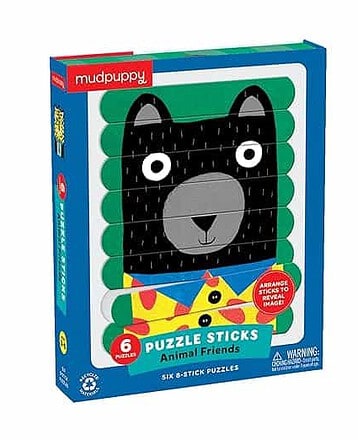Animal Friends Puzzle Sticks

Using games in therapy sessions
Animal Friends Puzzle Sticks is a great fun activity that can be used by speech & language therapists, occupational therapists, physical therapists and special education teachers. Games can make therapy fun and engaging for the child while the therapist can elicit responses and actions that meet therapy goals.
Animal Friends
Animal Friends Puzzle Sticks includes 24 double-sided puzzle sticks that create six 8-piece animal puzzles that can be used in therapy sessions. Completed puzzles feature illustrations of a chicken, a bear, a cat, a fox, a panda, and a leopard. Each puzzle has a unique background to help you sort and match the pieces.
Suggested lesson for Puzzle Sticks
“Today we’re going to play Puzzle Sticks and build some animal faces.”
“Spread the puzzle sticks out on the table.”
“Look at the pictures on the box, and pick a puzzle to assemble. We’ll assemble the Leopard.”
“The Leopard has a red background, so collect all the puzzle sticks with red ends.”
“Look at the Leopard picture for clues. The Leopard has two black Ears and a Hat at the top of their head. Find the stick with Ears, this is the top of the puzzle.”
“The Leopard is wearing a coat and tie. Look for these images with a Red Tie, these are the bottom of the puzzle.”
“Look at the picture. The Eyes are below the Ears and above the Nose and Mouth.”
“Move sticks higher or lower until the puzzle matches the picture.”
Incorporate articulation cards to work on sound development.
Incorporate vocabulary cards to improve vocabulary and language development.
Speech & Language Therapy
- Practice prepositions (on top of, in front of, next to, etc)
- Describe the animal in the puzzle
- Where would you find the animal?
- Practice sequence
Occupational Therapy
- Reinforce crossing the midline
- Sort the puzzle sticks by “end” colors
- Assemble the puzzle sticks, moving pieces up or down
- Sort the puzzle sticks by facial features (eyes, mouths, ears)
- Reinforce finger dexterity
Physical Therapy
- Improve large motor coordination
- Improve midline
- Improve trunk control
- Improve trunk stability
- Improve balance
- Imitate animal movement
Special Education
- Arrange the puzzle pieces by “end” color
- What color is the animal in the puzzle?
- Imitate the sound the animal would make
- Describe the animal by location
- Describe the animal by function
- Describe the animal by attributes
